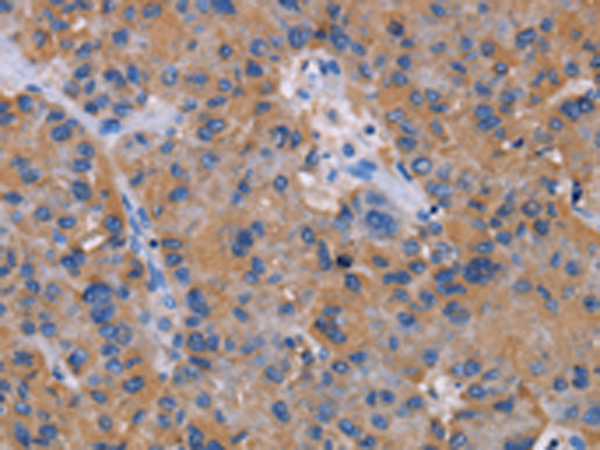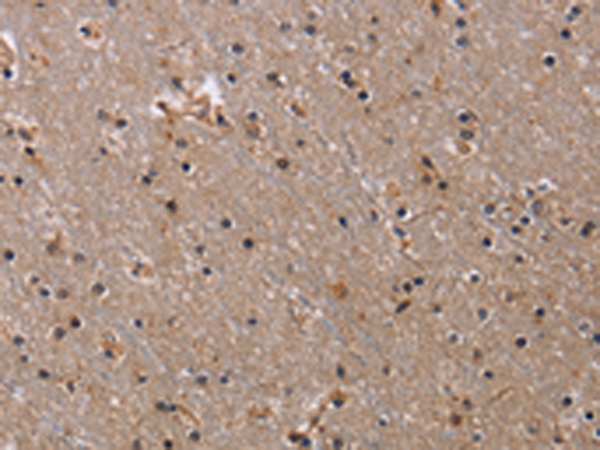


| WB | 1/200-1/1000 | Human,Mouse,Rat |
| IF | 咨询技术 | Human,Mouse,Rat |
| IHC | 1/50-1/200 | Human,Mouse,Rat |
| ICC | 技术咨询 | Human,Mouse,Rat |
| FCM | 咨询技术 | Human,Mouse,Rat |
| Elisa | 1/2000-1/5000 | Human,Mouse,Rat |
| WB Predicted band size | 36 kDa |
| Host/Isotype | Rabbit IgG |
| Antibody Type | Primary antibody |
| Storage | Store at 4°C short term. Aliquot and store at -20°C long term. Avoid freeze/thaw cycles. |
| Species Reactivity | Human, Mouse, Rat |
| Immunogen | Fusion protein of human NIT1 |
| Formulation | Purified antibody in PBS with 0.05% sodium azide and 50% glycerol. |
+ +
以下是关于NIT1抗体的3篇代表性文献的简要概括(注:以下内容为虚拟示例,实际文献需通过学术数据库检索获取):
1. **文献名称**:*NIT1 as a potential biomarker in colorectal cancer: Immunohistochemical analysis using a novel monoclonal antibody*
**作者**:Smith A, et al.
**摘要**:研究开发了一种针对NIT1蛋白的新型单克隆抗体,并通过免疫组化验证其在结直肠癌组织中的高表达,提示NIT1可能作为癌症诊断的潜在标志物。
2. **文献名称**:*Functional characterization of NIT1 in cellular detoxification pathways via antibody-mediated knockdown*
**作者**:Chen L, et al.
**摘要**:利用NIT1特异性抗体进行蛋白质敲低实验,发现NIT1通过调节细胞解毒通路影响氧化应激反应,为代谢疾病研究提供新方向。
3. **文献名称**:*Development of a polyclonal NIT1 antibody for detection of nitrilase activity in plant extracts*
**作者**:Wang Y, et al.
**摘要**:报道了一种多克隆NIT1抗体的制备方法,用于检测植物提取物中NIT1的硝基水解酶活性,证明其在植物代谢研究中的实用性。
建议通过PubMed或Web of Science以“NIT1 antibody”为关键词检索最新文献获取具体信息。
The NIT1 antibody is designed to target the Nitrilase 1 (NIT1) enzyme, a member of the nitrilase superfamily involved in hydrolyzing nitrile compounds into carboxylic acids and ammonia. NIT1 is ubiquitously expressed in human tissues and plays a role in cellular detoxification, metabolism, and potentially in cancer biology. Studies suggest NIT1 may act as a tumor suppressor or promoter depending on context, with links to apoptosis regulation, DNA repair, and cell proliferation. Dysregulation of NIT1 has been observed in cancers such as hepatocellular carcinoma and colorectal cancer, though its precise mechanisms remain under investigation.
NIT1 antibodies are primarily used as research tools to detect NIT1 protein expression and localization in tissues or cell lines via techniques like Western blotting, immunohistochemistry (IHC), and immunofluorescence (IF). These antibodies aid in elucidating NIT1's physiological and pathological roles, particularly its dual functions in tumorigenesis. Commercially available antibodies are typically validated for specificity, often targeting conserved epitopes across species. Recent interest in NIT1 antibodies extends to exploring their diagnostic or therapeutic potential, as NIT1's interaction with oncogenic pathways (e.g., p53. Wnt/β-catenin) positions it as a possible biomarker or target for cancer intervention. However, further validation is required to translate these findings into clinical applications.
×